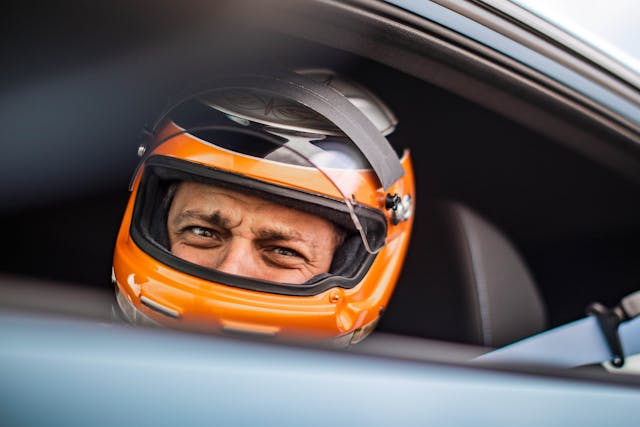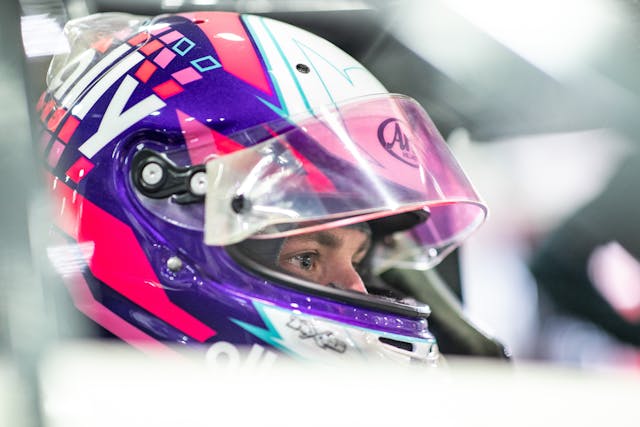Safety gear for racing beginners: Helmets
Shopping for clothes can be an overwhelming affair. Imagine going to the mall and picking out an outfit in which each article of clothing not only influences your style but could save your life.
Such are the stakes when shopping for motorsports safety gear. Throw into the mix acronyms, model names, and safety certifications, and a newcomer has every reason to throw up their hands.
To help demystify the gear-buying process, we’ve assembled a series on safety equipment for beginners, with help from industry expert Chris Emery of The Racers Safety Source.
“We believe in educating the driver to help them make the decision for their budget,” says Emery. “I’m not just here to sell someone the most expensive thing, because that might not be the best fit.”
This series will walk you through the basics for each piece, from helmets to shoes.

Let’s start with your head.
Part 1: Helmets
Before you make any helmet purchase, you should first check to make sure the model is Snell-certified. Named after racer Pete Snell, who lost his life in a 1956 SCCA race, the not-for-profit Snell Foundation develops and certifies helmet-safety standards. The organization tests over 3000 different helmets for disciplines ranging from horseback riding to car racing.
On the motorsports side of things, Snell Standards are updated every five years. You will want to look for a sticker that says “SA” or “Snell,” followed by the year in increments of five. SA2020 (or Snell2020), as of this writing, is the most recent certification year. In 2025, certified helmets will have an SA2025 sticker.

“You need to identify where and how you’ll use your helmet to determine the required rating,” says Emery. “SCCA, NASA, other driving clubs, and track-day groups traditionally require that the helmet is at least within 10 years of the current standard.”
Karters, you will want to look for a “K2020.” Fire protection is the biggest difference between karting and car-racing helmets. You can use an SA2020 for karting, but don’t ever use an K2020 in your car.
“I’ve seen people do something similar when they rush out and buy motorcycle helmets for high-performance driving at a track day or high-performance driver education [HPDE] course,” says Emery. “Car helmets are rated for impact and fire protection; motorcycle helmets are not.”

The next thing to examine is fit.
Like shoe companies, each helmet manufacturer tends to have a trademark fit. Stilo and Arai, for example, favor heads that are more oval-shaped due to the shape of their liner (the layer within the hard shell). Bell and Impact models tend to sit on the crown of the head, with rounder liners.
Of course, fit will vary within a single manufacturer’s range, and the differences between models can be minimized by swapping out different pads with varying thickness.
Higher-end helmets typically fit better. When building lower-quality models, a manufacturer may only send a couple shells to be certified by Snell, accommodating small to extra-large sizes by changing only the thickness of the padding inside the approved shell. On the flip side, a company like Arai will, most often, submit a shell to become certified with a correlating liner and matching pads.

When shopping, you’ll also want to be mindful of weight. Budget helmets tend to be heavier; lighter-weight materials, like carbon-fiber, push you further up the price bracket. Additional weight from more affordable composites could cause fatigue.
“If you don’t often go out and race, you might be lacking neck muscles or a strong core,” says Emery. “Even the g-forces from your street car on track will strain your neck.”
You’ll also want to consider the size of your helmet’s eye ports. Helmets like the Bell HP77 and the Arai GP7 are traditionally used by open-cockpit racers because they have smaller eye ports. Helmets like the Bell M8 and the Arai GP5W have larger eye ports for better visibility.

Helmets don’t last forever. That said, if you take care of them, they can last years. “It really depends how often you’re using it. Sweat and oils will breakdown pads or just make them stink,” says Emery. “If you can get three to five years out of your helmet, you’re doing a good job.”
Within that time, there will be another Snell certification year. Hello, SA2025.
Check out the selection of helmets at The Racers Safety Source.
Join us next time as we discuss driving suits.
Check out the Hagerty Media homepage so you don’t miss a single story, or better yet, bookmark it.


